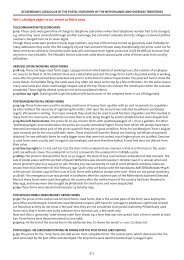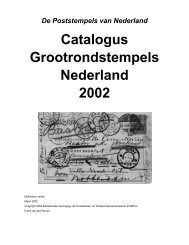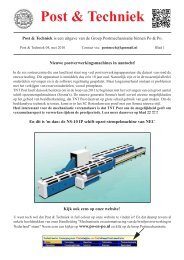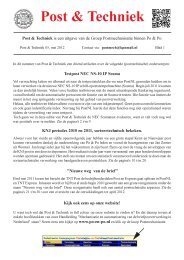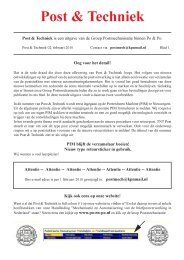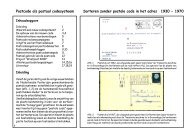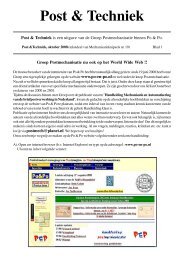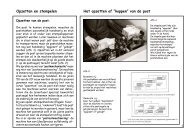GEUZENDAM catalogue pages 2
GEUZENDAM catalogue pages 2
GEUZENDAM catalogue pages 2
Create successful ePaper yourself
Turn your PDF publications into a flip-book with our unique Google optimized e-Paper software.
<strong>GEUZENDAM</strong>’S CATALOGUE OF THE POSTAL STATIONERY OF THE NETHERLANDS AND OVERSEAS TERRITORIES<br />
Part A, <strong>catalogue</strong> <strong>pages</strong> 2-18, version 30 March 2009<br />
The fi rst instalment of this Engish summary and vocabulary was published on the internet in April 2009. Gradually<br />
these texts will be added to and when necessary rectifi ed.<br />
²²²<br />
© Nederlandse Vereniging van Poststukken- en Poststempelverzamelaars<br />
All rights reserved. No part of this book may be reproduced, stored in a retrieval system, or transmitted in any form or<br />
by any means, electronic, mechanical, photocopying, recording or otherwise, without the prior permission in writing of<br />
the publisher.<br />
Philatelic Authors, Philatelists, Philatelic Dealers and Auctioneers may refer to the numbers in the listings provided<br />
these numbers are preceded by the capital letter G (or depending on the section P, S or V) and provided an explanation<br />
is given that this letter and number refer to the eighth edition of Geuzendam’s Catalogue of the Postal Stationery of<br />
the Netherlands and Overseas Territories.<br />
Whereas the <strong>catalogue</strong> is fully protected by copyright, an exception is made for this English summary and vocabulary.<br />
Collectors may feel free to make copies for their own use. Commercial copying and sale are however expressly forbidden.<br />
²²²<br />
A fully bilingual eighth edition of Geuzendam’s Postal Stationery Catalogue would have been ideal. This was however<br />
not practicable, mainly because of the costs and bulk of a volume of at least 500 <strong>pages</strong>.<br />
In this English summary and vocabulary we only give the information that is essential for general collectors. The vastly<br />
increased number of illustrations will be of great help. The introductions to some sections and a number of notes with<br />
historical and background information have either been condensed or omitted. It is perhaps not unreasonable to assume<br />
that advanced collectors will be suffi ciently profi cient in the Dutch language that they can read the full text without<br />
too much diffi culty.<br />
If this summary and vocabulary should in any way be incomplete or unclear, the editors would welcome users’ comments.<br />
The editors may be reached through P.O. Box 1065, 6801 BB ARNHEM, Netherlands or, until further notice, through e-mail<br />
at b.hellebrekers@planet.nl<br />
THROUGHOUT THIS ENGLISH TEXT THE WORD ‘CARD’ HAS BEEN USED BOTH AS A SHORT TERM FOR POSTCARD, CHANGE OF<br />
ADDRESS CARD ETC. AND TO INDICATE THE MATERIAL OF WHICH POSTCARDS AND OLDER LETTER CARDS ARE MADE.<br />
INHOUD/CONTENTS<br />
Verantwoording lit. ‘Justifi cation’<br />
Inleiding Introduction<br />
Enveloppen Envelopes<br />
Postbladen Letter cards and letter sheets<br />
Luchtpostbladen Air mail letter sheets<br />
Briefkaarten Postcards<br />
V-kaarten V-postcards<br />
Briefkaarten met perfi ns Postcards with perfi ns<br />
Verhuiskaarten Change of address cards<br />
Wijziging postadres Change of address card from P.O. Box to home address<br />
Kennisgeving telefoonnummer Notifi cation of telephone number<br />
Telecomkaarten Change of telephone number cards<br />
Arbeidslijsten Working hour forms<br />
Postbewijzen Postal order forms<br />
Postwisselformulieren Money order forms<br />
Postcheque- en girodienst Paying-in forms for the Post Offi ce giro service<br />
Busrechtformulieren P.O. Box fee-forms<br />
Aangetekend binnenland Inland registered mail envelopes<br />
Aangetekend met waardeaangifte binnenland Inland insured value seal bags<br />
Expresse-enveloppen buitenland International express mail envelopes<br />
A-1
<strong>GEUZENDAM</strong>’S CATALOGUE OF THE POSTAL STATIONERY OF THE NETHERLANDS AND OVERSEAS TERRITORIES<br />
Expresse-enveloppen binnenland Inland prepaid express mail envelopes<br />
Expressezegels binnenland Inland prepaid express mail labels<br />
Cassettepost Cassettepost<br />
PTT Post Kadoservice Gift service<br />
Roode Kruis Pakket-etiket Red Cross parcel label<br />
Europakketzegels Labels European parcel post<br />
Pakketzegels Labels inland parcel post<br />
Particuliere en beperkt verkrijgbare postwaardestukken Printed to order postal stationery and postal stationery that<br />
was not generally available<br />
Spoorwegbriefkaarten Railway postcards<br />
Banderolles en verpakkingen Postal stationery bands and packs<br />
Special sections overseas territories:<br />
Telegramontvangbewijzen Telegram receipt forms<br />
Veldpost Fieldpost<br />
Japanse bezetting Japanese occupation of the Netherlands East Indies<br />
Voorlopige Republiek Indonesië 1945-1949 Interim Republic of Indonesia<br />
Internationale Antwoordcoupons International Reply Coupons<br />
Regelgeving Nederland negentiende eeuw Postal regulations in the Netherlands in the 19th century<br />
concerning postal stationery<br />
Achtergronden en Bijzonderheden Background and particulars<br />
Tarieven Postal rates<br />
Afkortingen en verwijzingen Abbreviations and references<br />
Conversietabel oude nummers – nieuwe nummers Conversion table old numbers – new numbers<br />
VERANTWOORDING/JUSTIFICATION<br />
²²²<br />
#The editors were faced with a choice: either a somewhat extended version of the seventh edition, a glorifi ed price-list,<br />
which could be prepared in a relatively short time, or a step towards a truly specialized <strong>catalogue</strong>, which would take<br />
years of preparation. It is clear that we chose for the second option.<br />
#The wish to supply much background information led to the creation of the chapters ‘Background and particulars’<br />
(of which the texts however are not fully translated or summarized). In this way the main text would not be swamped<br />
with information that was not absolutely necessary for identifying items of postal stationery. The user is referred to<br />
these chapters by signs with two asterisks, e.g. pbl G3-G7.<br />
#The aim of the editors was to base this <strong>catalogue</strong> as much as possible on chronology. This has caused sometimes<br />
major changes in the numbering.<br />
#Quite a few new chapters have been added and several old chapters have been revised.<br />
#After some hesitation the editors decided to include some subjects that stricly speaking are not ‘postal stationery’<br />
(FIP defi nition!). These groups are felt by many collectors to be ‘related’, and, as in the case of the ‘labels for the inland<br />
parcel post’, might even not be <strong>catalogue</strong>d at all if they were not included in this <strong>catalogue</strong>.<br />
#Some chapters do not give full listings as suffi cient information is not (yet) available.<br />
#For the same reason in some chapters only price ranges are given.<br />
INLEIDING/INTRODUCTION<br />
In the Introduction a number of aspects and considerations concerning postal stationery are treated. The sections will<br />
be commented on summarily. The subjects are treated in the same order as in the Dutch introduction.<br />
#Defi nition Postal Stationery: See FIP-regulations.<br />
#Addenda & corrigenda: To be found on this internet site.<br />
#Sizes: Lettercodes of previous editions have been replaced by millimeter-indications, with the exception of ‘Labels inland<br />
parcel post’. Older items may show more variation than indicated. Letter sheet and Air mail letter sheet sizes are for unfolded<br />
items, not including the gummed folding fl aps of modern Letter sheets and Air mail letter sheets. In 295x150||3<br />
the number 3 indicates the number of folding fl aps.<br />
#Anomalies: The number of variations (miscuts, shifted printing, double printing, missing colour, one side of reply card<br />
without printing, all manners of anomalies in overprints) is far greater than indicated.<br />
A-2
<strong>GEUZENDAM</strong>’S CATALOGUE OF THE POSTAL STATIONERY OF THE NETHERLANDS AND OVERSEAS TERRITORIES<br />
#Preservation: A useful internet site is http://www.stamps.org/care/pcpm.htm<br />
#Reply paid postcards: Normally a reply card should have been used after it had been separated from the outward card.<br />
It should be mentioned that in international postal relations double use – the used outward card still attached to the<br />
reply card – was offi cially forbidden after 1907. On the return journey such ‘doubly used’ cards should have been<br />
franked at letter rate. It is as yet unclear if the same regulation existed for inland double cards. There are many doubly<br />
used inland cards of which the return card is not franked at letter rate.<br />
#Additional franking: See also Prices. Sometimes a postcard etc. for a new rate was not yet available when a new<br />
rate was introduced, sometimes post offi ces were instructed to sell old stock with an additional stamp before breaking<br />
into the stock of new items. Sometimes additional franking adds to the interest of stationery: Registered mail, Express<br />
service, Airmail etc. From 1936 onwards postcards are found with apparent additional franking: no special handling was<br />
required and the value of the additional stamps far exceeds a normal rate increase. The value of the additional stamps<br />
on such postcards, often bearing a solution to a puzzle, was for charity.<br />
#Printing process: A printing process is only mentioned and illustrated when confusion is possible between similar<br />
items which were however differently produced.<br />
#Envelopes, envelope models, inside printing: These are schematically illustrated on the inside of the back cover.<br />
#Phosphor bands: The position of the phosphor band is indicated as follows: FL to the left of the stamp, FM on the stamp,<br />
FR to the right of the stamp. With the exception of postcard G389 all phosphor marks are vertical bands.<br />
Variation in the sizes of phosphor bands is in a number of cases refl ected by subnumbers but it seems that in the printing<br />
process the phosphor band was sometimes applied with less care than the stamp imprint etc., causing uneven or run out<br />
bands. Further research may lead to the conclusion that some phosphor bands, especially for the change of address cards,<br />
which are at present considered to be characteristic, are in fact no more than unintentional variations.<br />
#Photo postcards: The horizontal photo cards in the series G240 and G284 exist with the photo oriented as the address<br />
side (rechtstaand) or inverted (kopstaand). To differentiate between these versions: view address side of postcard in<br />
normal position, that is the texts are legible. Then rotate the postcard on its short, vertical axis. If the photo is in the<br />
upright position it is ‘rechtstaand’; if the photo is inverted it is ‘kopstaand’.<br />
#Used/genuinely used: See Prices.<br />
#Colours: As long as there is no practical international standard for colour-names, we have to muddle along with<br />
approximations. Moreover, even for stationery items that were printed in one run, there may be differences in colour,<br />
both of paper or card and stamp imprint. Then, also age and conditions under which the items were preserved may<br />
have infl uenced the colours: temperature, humidity, light, oxydization.<br />
#Quality: It is unreasonable to demand the same quality for 19th century issues and recent issues, especially for issues of the<br />
overseas territories. Broadly speaking, very slight defects in postcards before 1900 and envelopes and letter cards before<br />
1914 may be acceptable, especially for used items. Items that are torn, discoloured or from which additional stamps<br />
have been removed, are usually unacceptable. Non-postal annotations in ink, aniline pencil etc. reduce the value,<br />
sometimes dramatically. Owners’ stamps and labels, frequently found in older collections, at the very least detract<br />
from the visual quality. If one insists on putting a <strong>catalogue</strong> number on an item, this should be done on the back with<br />
a very soft pencil.<br />
#Mail - Seapost: These terms are important in the context of the postal rates, especially in the 19th century.<br />
Mail (sometimes called Indirect Mail): letters etc. were shipped through intermediate ports such as Southampton,<br />
Liverpool, New York, Naples, Marseille, St. Nazaire, Brindisi.<br />
Seapost (sometimes called Direct Mail): letters etc. were shipped straight between the overseas territories and the Netherlands.<br />
The word ‘direct’ does not imply quicker transport, it only implies that no other Postal Organisations were involved.<br />
#New numbers: Many items were assigned new numbers, esp. in the chapter Postcards of the Netherlands. Old numbers<br />
(of the seventh edition) are given between square brackets.<br />
For composition variants the suffi x z has been introduced.<br />
The so-called ‘V-kaarten’ have all been assigned new numbers. They are dealt with in a separate chapter.<br />
The numbers of ‘Printed to order Postal Stationery and Postal Stationery that was not generally available’ are preceded<br />
by P when they are based on a regular postal stationery item, by PP + the last two digits of the year of issue + a serial<br />
number when no regular item with the same stamp design was issued.<br />
The numbers of the railway postcards are preceded by an S. They are preceded by PS when they also fall into the<br />
category ‘Printed to order’.<br />
#Numbering system: The editors advise the use of hyphens in composite numbers.<br />
#Designers: Names of designers of stamps and lay-out are given whenever possible.<br />
#Quantities printed: The Dutch word ‘oplage’ suggests a number of items printed in one run, all showing the same<br />
characteristics. This need not be true, however: for envelopes especially as now and then basic envelopes were used<br />
that were similar in size and paper colour but differed in inside printing. In the <strong>catalogue</strong> the word ‘oplage’ is however<br />
used for the total number printed. In most cases the source for this number are the ‘geschiedeniskaarten’ (lit. ‘history<br />
charts’), the administration kept bij PTT from 1924 to 1988. Data from the preceding period were later incorporated in the<br />
‘geschiedeniskaarten’.<br />
A-3
<strong>GEUZENDAM</strong>’S CATALOGUE OF THE POSTAL STATIONERY OF THE NETHERLANDS AND OVERSEAS TERRITORIES<br />
The ‘geschiedeniskaarten’ give the number ordered and the number delivered by the printer’s, not necessarily exactly<br />
the same. Numbers returned and/or destroyed are not given, nor are the numbers that were sold through the Philatelic<br />
Service. This is especially important for the Overseas Territories because the rarity of some used items of the 1920s and<br />
1930s can thus be explained: quite a few were sold in the Netherlands through the Service and these usually remained<br />
in the Netherlands and were never used.<br />
#Overprinted postcards 1916-1921: See chapter on V-postcards<br />
#Paper and Card:<br />
Colour: The most frequently found colours are white and buff, the latter in many shades.<br />
Thickness: Formerly many variations in thickness were given that could not be found when a paper gauge was used.<br />
These differences had been established by feeling the material with the fi ngers: stiff card was judged to be thicker<br />
than limp card. In this <strong>catalogue</strong> differences are only given when estabished with a paper gauge. In most cases we<br />
have not been able to relate differences in thickness to certain printings.<br />
Several older postcard issues exist on smooth and on ribbed card. Usually ribbed card is slightly thicker than smooth<br />
card.<br />
Differences in paper and card caused by the addition of optical whitener or the presence of coloured fi bres can be<br />
detected with UV-light.<br />
#Printed to order Postal stationery and Postal Stationery that was not generally available: Some items that in previous<br />
editions fi gured among the regular issues have been relegated to this chapter.<br />
#Privately added print: In recent years the fad has grown to assign a (sometimes considerably) greater value to items<br />
with privately added print such as sender’s address, printed reminder for outstanding debts, order form text etc. In the<br />
editors’ opinion there are no grounds at all for such an increase.<br />
However, a distinction should be made between on the one hand postcards etc. with privately added texts which were<br />
exclusively used by the persons or fi rms who had them printed or their customers, and on the other hand the ‘particulier<br />
bedrukte postwaardestukken’ as described in the 1981 Geuzendam <strong>catalogue</strong>.<br />
In this <strong>catalogue</strong> A.W. ten Geuzendam mentions three groups of postal stationery with privately added print that<br />
deserve philatelic recognition:<br />
1. Items with added illustrations and/or texts involving tourism or concerning manifestations of limited duration such<br />
as exhibitions, the investiture of Queen Wilhelmina.<br />
2. Items with added illustrations and/or texts concerning philatelic manifestations.<br />
3. Items with added illustrations and/or texts connected with publicity (often sold at a lower price than face value) or<br />
with charity (often sold at a higher price than face value).<br />
The decisive factor is that the items in these three categories could be bought and used by the general public.<br />
None of these three groups is dealt with in this <strong>catalogue</strong>.<br />
Then there is the group of Railway postcards, sometimes incorrectly referred to as ‘semi-offi cial’. Out of the several<br />
hundred of these cards only 23 are genuinely ‘printed to order’, on all the other cards the text was privately added.<br />
All the railway postcards however are dealt with on the <strong>pages</strong> 188-196.<br />
#Prices: See also ‘Additional franking’, ‘privately added print’, ‘postmarks, commemorative postmarks and special fl ights’.<br />
Prices are in euros with one digit after the comma. Dutch uses commas where English uses decimal points.<br />
The left-hand column is for mint items, the right hand column for used items. A few sections have three columns, for<br />
explanation see introductions to those sections.<br />
Mentioning a price in a <strong>catalogue</strong> suggests that an item can be bought at that price. This need not be true, certainly<br />
not for rare and very rare items. The <strong>catalogue</strong> price is then an indication of the level of the price one may have to pay.<br />
Prices ‘used’ are for genuinely used, non-philatelic items without additional franking and used in accordance with the<br />
postal rates. This does not mean that items with additional franking are without value and not worth collecting. In<br />
many cases the contrary is true, but each case will have to be judged on its own merits.<br />
Some prices are in italics. This indicates that extremely limited information has led to estimates being given.<br />
Whenever we have not been able to establish a price, the sign --,- is used. The reason may be the absence of market<br />
data or, especially for certain modern items, absence of supply and demand.<br />
When an item cannot exist or is not known to exist mint or used, the relative column is left blank.<br />
For some categories there are no individual prices at all or only a price range is indicated , e.g. ‘tussen € 40 and € 80’,<br />
again due to lack of information.<br />
The used halves of reply paid cards are priced: the V-kaart is the Outward half, the A-kaart is the Reply half. Usually<br />
reply paid cards of which both parts have been used and are still attached, command a higher price. It is up to the individual<br />
collector to decide whether such unnatural items are worth collecting. See also paragraph on Reply Paid Postcards.<br />
A-4
<strong>GEUZENDAM</strong>’S CATALOGUE OF THE POSTAL STATIONERY OF THE NETHERLANDS AND OVERSEAS TERRITORIES<br />
For letter cards there are three columns, the fi rst column for mint items, the second column for used items complete<br />
with edges, the third column for used items without edges. It should be noted that used items with edges are in many<br />
cases of philatelic origin. It is up to the individual collector to decide whether such unnatural items are worth collecting.<br />
In a few instances the type of a used item without edges cannot be ascertained.<br />
For Working Hour Forms there are also three columns, the fi rst for the complete mint form including the postcard, the<br />
second for the mint postcard, the third for the used postcard.<br />
Especially for the former colonies it is important to distinguish between ‘used’ and ‘genuinely used’, that is of non-philatelic<br />
origin. Some items of the 1920s and 1930s are almost exclusively known sent by / to philatelists. We should nevertheless<br />
recognize that we are indebted to the collectors of that period for the envelopes and postcards they sent, thus contributing<br />
to our knowledge. The prices are for ‘genuinely used’.<br />
#Screen: In recent years the aspect ‘screen’ of the printing process of stamps and postal stationery has been extensively<br />
dealt with in the Dutch monthly ‘Filatelie’. So far there is only one instance in postal stationery where ‘screen’ is of<br />
importance for recognizing the variety, the sender’s lines of postcards G387 (screen //////) and G388 (screen xxxxxx).<br />
#Route markings: These are summarily dealt with in the chapters ‘Background and particulars’ of NEI, Curaçao and Surinam.<br />
#Dividing line: Until 1904 postcards had no dividing line. From 1904 till 1908 they had, with the exception of the experimental<br />
issue G73, a short dividing line. From late 1908 till early 1921 nearly all postcards were produced in two versions,<br />
short dividing and long dividing line. From then on only postcards with long dividing line were issued.<br />
#Postmarks, commemorative postmarks and special fl ights: Already before WW II, but especially in the 1940s , 1950s<br />
and 1960s many postcards, change of address cards and air mail letter sheets were used by collectors to acquire such<br />
postmarks. Postal stationery was then not used for the purpose for which it had been issued: there was no correspon-<br />
dence and in the case of the change of address cards, no change of address. Quite regularly items were used that were<br />
diffi cult to obtain as normally used stationery, e.g. change of address cards G14 and G20, postcards G294, G301, G314.<br />
In the 1920s and 1930s many NEI change of address cards were similarly used.<br />
As a rule the value of such items does not exceed the value of the postmark.<br />
#Rates (<strong>pages</strong> 326-347): As envelopes were quite often used for the second weight step, the rate for that weight step is<br />
indicated between square brackets whenever the rate was not simply doubled.<br />
Possibly not all information about the postal rates of Curaçao and Surinam has come to light.<br />
#Dates of issue: There is much uncertainty about dates of issue. Even when a fi rst day of sale had been determined postal<br />
stationery was sometimes sold earlier. The dates in this <strong>catalogue</strong> are as much as possible based on offi cial documents.<br />
From the 1960s for a number of years attentive collectors, dealers and the Philatelic Service produced fi rst day postcards<br />
etc. Sometimes the dates do not concur, and the Philatelic Service has sometimes sold items with ‘fi rst day postmarks’<br />
which in our view are not in accord with the fi rst date of availibility at post offi ces.<br />
The records of the Issuing Offi ce give information on the dates when items were ordered and on the dates when they<br />
were delivered by the printer’s. In theory this last date or the day after could be the fi rst day of sale, but actually this is<br />
rarely, or perhaps never, the case. Many items were only put on sale months after they had been delivered by the printer’s<br />
to the Issuing Offi ce because the old stock or the old model had to be sold off fi rst. Quite often however postal stationery<br />
for a new postal rate was on sale days or weeks before the introduction of the new rate.<br />
The term vbd (vroegst bekende datum) has been introduced, in English Earliest Date Recorded Date (EDR). It should be<br />
noted that sometimes the EDR precedes the offi cial fi rst day.<br />
A question mark (?) with a date, indicates that we had to fall back on a traditional unverifi ed date.<br />
An x in a date, especially instead of the month, indicates that that particular part of a date stamp was illegible.<br />
It is even more diffi cult to fi nd information about the dates of issue of the postal stationery of the Overseas Territories.<br />
Before WW II the philatelic press in the Netherlands often announced new issues for those territories that had been<br />
bought through the Philatelic Service in the Netherlands. Quite often those items were not yet on sale overseas,<br />
sometimes, it seems, they had not even reached their overseas destination at that moment, a voyage that took at<br />
least three weeks. Moreover many issues were not put on sale immediately, old stocks had to be sold off fi rst. Reply<br />
paid postcards sold slowly and sometimes new issues did not reach the post offi ces at all or very late in very limited<br />
numbers. We know that a number of earliest dates fi nd their origin in postcards or envelopes that were bought in the<br />
Netherlands and sent to overseas philatelic contacts with the request to post them.<br />
#Cutouts:<br />
a. In the Netherlands, as in most European countries, Postal Stationery is collected as entires.<br />
b. In the Netherlands there has not always been a clear policy concerning the acceptance of cut outs to frank other<br />
postal objects. In the 19th century such use was prohibited. Nevertheless examples of such use are found that have<br />
not been taxed. From late 1972 till the present day such use is permitted. It is unclear whether at any time in the<br />
fi rst half of the 20th century the use of cut outs was permitted. In any case examples of such use are fairly frequently<br />
found, in many cases discovered and treated as unfranked.<br />
A-5
<strong>GEUZENDAM</strong>’S CATALOGUE OF THE POSTAL STATIONERY OF THE NETHERLANDS AND OVERSEAS TERRITORIES<br />
#Bands and Packs: There are hardly any archival data concerning packaging. Usually postal stationery was supplied by the<br />
printer’s in packets of 10, 25 or sometimes 100, held together by a paper band. Few of these bands have survived as they<br />
were of no importance at the time to the post offi ce, customers and collectors. Some examples are shown on <strong>pages</strong><br />
197 and 198. In the period 1914-1919 a number of postcards were sold in strips of 1o, separated by a perforation. These<br />
cards, especially meant for use in typewriters, of course drew the attention of collectors and a somewhat larger percentage<br />
of bands was preserved (see ill. on <strong>pages</strong> 197 and 299).<br />
The small-sized envelopes of the 1940s were supplied in boxes of 100, most of which did not reach the public. It is<br />
quite likely that other envelopes and letter cards were also supplied in boxes.<br />
Later packages of 100 postcards and change of address cards were introduced with a thin coloured sheet of paper after<br />
every tenth card. From 1995 onwards they were also sold in packs of 5 or 10, at fi rst held together by transparent shrink<br />
wrapping, and with a stick-on label describing the contents (see left-hand column on page 199), later in cardboard packages,<br />
still later with a cardboard stiffener in clear shrink wrapping. Parcelstamps were sold singly and in stampbook form (page<br />
201, left-hand column). From January 2001 postal stationery was exclusively sold in packages of 5 or 10.<br />
#Fakes and Expertise: For some items, especially 19th century overprints from the Overseas Territories, experts’ certifi -<br />
cates are necessary.<br />
#Coats of Arms: The types of coats of arms on letter cards and postcards that are necessary for identifi cation are illustrated<br />
on the inside back cover.<br />
#Seapost: See Mail - Seapost<br />
#zeerecht: sea charge From 1 April 1879 member countries of the UPU could adopt a higher rate for overseas letters<br />
and postcards transported over a distance of more than 300 nautical miles. The Netherlands abolished the sea charge<br />
as of 1 July 1892. A number of overseas destinations were exempt even though the overseas mail route was longer<br />
than 300 nautical miles. See list at bottom of page 17 and top of page 18.<br />
#Composition variants: Variants which are assumed to have occurred in the same sheet are indicated by the letter z:<br />
z-1, z-2 etc.<br />
#ZWI: = NVI - Non Value Indicator<br />
A-6



